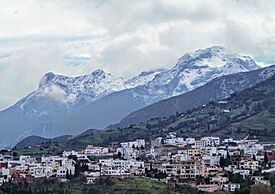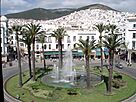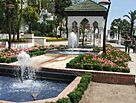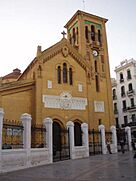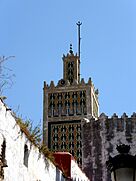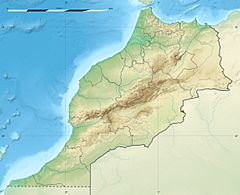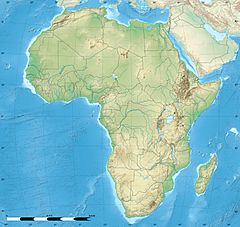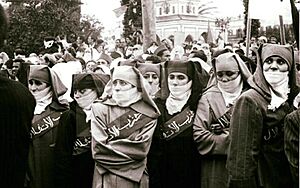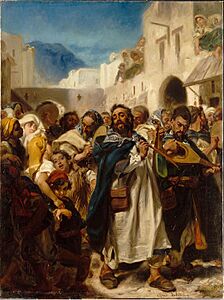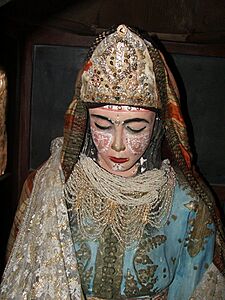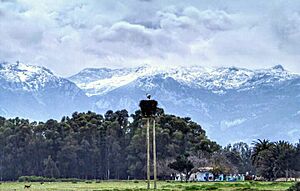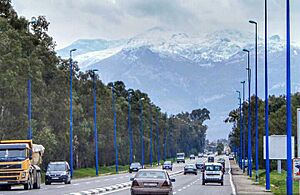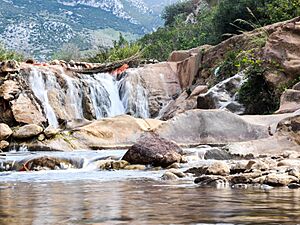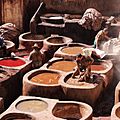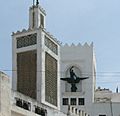Tétouan facts for kids
Quick facts for kids
Tétouan
تطوان
|
||
|---|---|---|
|
City and municipality
|
||
|
Overview
|
||
|
||
| Nickname(s):
Granada's Daughter
The White Dove |
||
| Country | ||
| Region | Tanger-Tetouan-Al Hoceima | |
| Province | Tétouan | |
| Highest elevation | 205 m (673 ft) | |
| Lowest elevation | 2 m (7 ft) | |
| Population
(2014)
|
||
| • Total | 380,787 | |
| • Rank | 11th in Morocco | |
| Time zone | UTC+1 (CET) | |
| Postal Code |
93000
|
|
| Website | The official web site: http://www.tetouan.ma | |
| Official name: Medina of Tétouan (formerly known as Titawin) | ||
| Type: | Cultural | |
| Criteria: | ii, iv, v | |
| Designated: | 1997 (21st session) | |
| Reference #: | 837 | |
| Region: | Arab States | |
Tétouan (Arabic: تطوان, romanized: tiṭwān) is a city in northern Morocco. It is one of Morocco's main ports on the Mediterranean Sea. The city is located a few miles south of the Strait of Gibraltar. It is about 60 kilometers (37 miles) southeast of Tangier.
In 2014, Tétouan had a population of 380,787 people. It is part of the Tanger-Tetouan-Al Hoceima region.
Tétouan has a very long history, going back over 2,000 years. The first settlements were by ancient Mauretanians around 300 BC. Later, Phoenicians traded here. The site then became a Roman colony called Tamuda.
In the late 1200s, the Marinids built a fortress (casbah) and a mosque. The city was later destroyed in the early 1400s.
The modern city was rebuilt around the late 1400s. Ali al-Mandri, who came from Granada in Spain, helped rebuild and fortify it. Thousands of Muslims and Jews from Spain settled here. Tétouan became a center for Andalusian culture. It is often called "Granada's Daughter." Some families still have keys to their old homes in Granada.
From 1913 to 1956, Tétouan was the capital of the Spanish protectorate of Morocco. This was when Spain ruled parts of Morocco. The city became fully independent in 1956.
Tétouan is known for its many cultures. Its old city, called the medina, is a UNESCO World Heritage Site since 1997. It is also part of the UNESCO Creative Cities Network for Crafts and Folk Art.
Contents
What's in a Name?
The name Tétouan might come from an old word meaning "eye." This is according to a writer named Leo Africanus. He wrote that the city was once governed by a woman with one eye.
The name was first written down in Arabic records in the 800s.
Tétouan's Long History
Early Settlements: Phoenicians and Romans
A few miles outside Tétouan, you can find the ancient town of Tamuda. The first people to live here were the ancient Mauretanians around 300 BC.
Archaeologists have found items from both the Phoenicians and the Romans at Tamuda. It became a Roman colony under Emperor Augustus.
Rebuilding the City
In 1286, the Marinids built a fortress (casbah) and a mosque in the area. In 1305, Sultan Abu Thabit Amir made the settlement bigger and stronger. He used it as a base to attack Ceuta.
In 1399, the city was destroyed by the Castilians (from Spain). They did this because pirates were using Tétouan as a base.
By the late 1400s, the city was rebuilt. Many refugees from the Reconquista (when Christians took back Spain) came here. These Andalusian Moors were led by Ali al-Mandri. They built new walls and houses.
These new settlers worked with local tribes. They also started attacking Spanish areas along the Moroccan coast. This led to the Spanish destroying Tétouan's harbor in 1565. During this time, the city was mostly independent from the central Moroccan government.
Pirates and Hidden Prisons
In the 1530s, Tétouan became a major center for piracy. Pirates saw this as revenge for losing their homes in Spain. Many Moriscos (Muslims forced to convert to Christianity in Spain) also came to Tétouan.
The pirates captured people and took them to underground prisons called Mazmorras. These were like hidden caves. Captives could be sold into slavery if their families did not pay a ransom.
These underground prisons were found again in the early 1900s. A small chapel was also found. Captives and people trying to free them, like Spanish Franciscans, used this chapel.
The famous writer Miguel de Cervantes mentioned Mazmorras in his books. He likely heard about them from prisoners he met. Piracy continued until 1829, when the Austrian Empire attacked the city.
Today, these underground prisons are not open to the public. Researchers hope to explore and restore them in the future.
Later Military History
In the 1600s, a rich family ruled Tétouan. Later, the Alaouite sultan Moulay Ismail took control. Tétouan became more stable when an Alaouite governor took over. He built important landmarks like the Meshwar palace and the Pasha mosque.
The city's old walls, seven gates, and three forts still show its military past.
After 1830, many Algerians moved to Tétouan after France invaded Algiers. They brought new foods like baklava and coffee.
Spanish Influence and Independence

In 1859, Spain declared war on Morocco. On February 4, 1860, Spanish forces led by General Leopoldo O'Donnell captured Tétouan. He was later made the Duke of Tetuán. However, Spain left the city in May 1862.
In 1913, Tétouan became the capital of the Spanish protectorate of Morocco. It remained the capital until Morocco became fully independent in 1956.
The Fight for Freedom
Tétouan was a very active city in resisting colonial rule. Leaders like Abdelkhalek Torres and Mohammed Daoud led the nationalist movement. They worked with other Arab leaders. Many members later joined the National Party for Istiqlal. Women were also important members of these groups.
Jewish Community in Tétouan
Tétouan had a large Sephardi Jewish community. They came from Spain after the Spanish Inquisition. They spoke a special language called Haketia, which is a form of Judaeo-Spanish.
In 1790, there was an attack on the Jewish quarter (mellah). Many Jews moved to Gibraltar. In 1807, the mellah was moved to build a large mosque.
In 1860, the mellah was attacked again during the Hispano-Moroccan War. This led to international help for the Jewish community. The Alliance Israélite Universelle opened its first school in Tétouan in 1862.
After 1948, most Jews left Morocco. Today, very few Jews remain in Tétouan. The Rabbi Isaac Bengualid Synagogue is now a museum.
Tétouan in Modern Times
Tétouan grew even more when it was the capital of the Spanish protectorate. New neighborhoods were built outside the old city walls. These areas, called "Ensanche" (meaning extension), looked like other Spanish cities.
In 1984, there were protests in Tétouan and other cities. This was due to rising prices of basic goods. The protests were stopped by the military.
Many people in Tétouan still speak Spanish. Road signs often show names in both Spanish and Arabic. French is also widely used in Morocco.
Tétouan's Culture
Tétouan is famous for its beautiful crafts and music. It is part of the UNESCO Creative Cities Network for Crafts and Folk Art. The city's culture mixes influences from Andalusian, Berber, Jewish, and Spanish traditions.
Books and Newspapers
Tétouan has produced many smart people over the centuries. One of Morocco's first newspapers, El Eco de Tetuan, was published here in 1860.
During the colonial period, Tétouan became a center for publishing. Many important newspapers were printed here, including the first nationalist paper, as-Salaam. These papers were published by thinkers like Abdesalam Bennuna and Mohammed Daoud.
Religions in Tétouan
Most people in Tétouan are Muslims. There is also a small Christian community. The number of Jewish people has become very small in recent years.
Amazing Buildings
The streets in Tétouan are quite wide. Many old houses belonging to noble families have marble fountains and orange trees. The ceilings inside houses are often beautifully carved and painted. They look like designs found in the Alhambra in Spain. The city is also known for its colorful tilework.
Tétouan has seven gates that used to close at night. Many Sufi religious centers (Zawiyas) are found in the old city.
Delicious Food
Tétouan has special food traditions. Its food mixes Arab, Amazigh, Andalusi, Turkish, and Spanish influences.
You can find common Moroccan dishes like couscous and rafissa.
The city also has Andalusian cooking traditions, brought by refugees from Spain. A classic dish is pastilla. Tétouan's pastilla is more savory, with preserved lemon and no sugar or almonds.
Algerian and Ottoman food have also influenced Tétouan. This is seen in sweets like qatayef and baklava.
Local Crafts
Traditional crafts are made in the old medina. Each craft has its own area with workshops and shops. These crafts include Zellige (tilework), pottery, plaster carvings, embroidery, and making yellow slippers.
Museums and Fun Festivals
The Lucas Museum of Religious Heritage is in an old school building. Tétouan also has museums for archaeology, traditional art, and modern art. There is a music school and many craft schools.
Tétouan is known for its traditional Andalusian classical music. Folk singers like Abdessadeq Cheqara are very popular. Other local music styles are played at weddings.
The city hosts international festivals, like the Mediterranean Film Festival. The International Oud and Women's Voice Festival is also held here.
In 2013, the city opened its Centro de Arte Moderno (Center of Modern Art). It shows artworks from local artists.
Tétouan's Dialect
Tétouan has its own special way of speaking Arabic. It is different from the Arabic spoken in nearby rural areas. However, many people from rural areas have moved to the city, so their dialect is also common.
Spanish and French are still widely spoken. This is because of past colonial ties and being close to Europe.
Tétouan's Location and Weather
Tétouan is about 60 kilometers (37 miles) east of Tangier. It is 40 kilometers (25 miles) south of the Strait of Gibraltar. Mountains are to the south and west of the city.
Tétouan is surrounded by orchards. They grow oranges, almonds, pomegranates, and cypress trees. The Rif Mountains are very close. The city is in the Martil Valley. It sits on the northern side of this valley, with the Martil river flowing through it.
Climate
Tétouan has a Mediterranean climate. This means it has mild, cold, and rainy winters. Summers are hot and dry.
| Climate data for Tétouan 1991–2020 normals, 1961–present extremes | |||||||||||||
|---|---|---|---|---|---|---|---|---|---|---|---|---|---|
| Month | Jan | Feb | Mar | Apr | May | Jun | Jul | Aug | Sep | Oct | Nov | Dec | Year |
| Record high °C (°F) | 25.4 (77.7) |
27.5 (81.5) |
31.0 (87.8) |
30.3 (86.5) |
35.1 (95.2) |
38.9 (102.0) |
42.5 (108.5) |
43.1 (109.6) |
36.2 (97.2) |
34.8 (94.6) |
34.0 (93.2) |
30.1 (86.2) |
43.1 (109.6) |
| Mean daily maximum °C (°F) | 17.4 (63.3) |
17.7 (63.9) |
19.0 (66.2) |
20.7 (69.3) |
23.4 (74.1) |
27.1 (80.8) |
30.0 (86.0) |
30.3 (86.5) |
27.6 (81.7) |
24.2 (75.6) |
20.5 (68.9) |
18.2 (64.8) |
23.0 (73.4) |
| Daily mean °C (°F) | 13.4 (56.1) |
13.9 (57.0) |
15.3 (59.5) |
16.7 (62.1) |
19.1 (66.4) |
22.5 (72.5) |
25.1 (77.2) |
25.9 (78.6) |
23.6 (74.5) |
20.3 (68.5) |
16.6 (61.9) |
14.4 (57.9) |
18.9 (66.0) |
| Mean daily minimum °C (°F) | 9.3 (48.7) |
10.0 (50.0) |
11.5 (52.7) |
12.9 (55.2) |
15.2 (59.4) |
18.4 (65.1) |
20.7 (69.3) |
21.4 (70.5) |
19.5 (67.1) |
16.4 (61.5) |
12.7 (54.9) |
10.5 (50.9) |
14.9 (58.8) |
| Record low °C (°F) | −2.3 (27.9) |
−1.0 (30.2) |
−0.5 (31.1) |
0.0 (32.0) |
4.0 (39.2) |
7.0 (44.6) |
10.4 (50.7) |
5.4 (41.7) |
10.9 (51.6) |
0.0 (32.0) |
0.0 (32.0) |
0.0 (32.0) |
−2.3 (27.9) |
| Average precipitation mm (inches) | 93.4 (3.68) |
86.6 (3.41) |
73.1 (2.88) |
62.4 (2.46) |
30.1 (1.19) |
7.6 (0.30) |
0.6 (0.02) |
4.7 (0.19) |
28.8 (1.13) |
74.8 (2.94) |
92.2 (3.63) |
100.4 (3.95) |
654.7 (25.78) |
| Average precipitation days (≥ 1 mm) | 7.6 | 7.4 | 7.4 | 6.8 | 4.4 | 1.0 | 0.2 | 0.6 | 3.1 | 6.8 | 7.7 | 8.7 | 61.7 |
| Average relative humidity (%) (at 7:00) | 83 | 83 | 86 | 85 | 79 | 78 | 75 | 77 | 84 | 85 | 86 | 82 | 82 |
| Mean monthly sunshine hours | 176.7 | 180.0 | 182.9 | 201.0 | 282.1 | 306.0 | 325.5 | 306.9 | 237.0 | 204.6 | 159.0 | 167.4 | 2,729.1 |
| Mean daily sunshine hours | 5.7 | 6.3 | 5.9 | 6.7 | 9.1 | 10.2 | 10.5 | 9.9 | 7.9 | 6.6 | 5.3 | 5.4 | 7.5 |
| Source 1: NOAA | |||||||||||||
| Source 2: Deutscher Wetterdienst (humidity, sun 1961–1990), Météo climat (extremes) | |||||||||||||
Learning and Schools
Education and the Nationalist Movement
In the 1920s, people fighting for Moroccan independence in Tétouan focused on education. They believed it was key to fighting colonialism. In 1924, they opened a primary school called "Al Madrasa al-Ahliyah" (National School).
Leaders like Mohammed Daoud helped make this happen. In 1935, they decided to open a secondary school. It was named the Free Institute.
Students at the Free Institute were among the first to protest against Spanish rule. In 1948, a student was killed during protests for independence. The Spanish government then took over the institute. Staff members were arrested.
However, the school continued. Older students helped teach the younger ones. Many graduates went on to study in Spain, Cairo, and Baghdad.
Other Schools and Universities
Tétouan is home to l'Institut National des Beaux-Arts (National Institute of Fine Arts). This is Morocco's only national arts college. It was founded in 1945.
The city also has the Ecole Nationale d'Architecture, a public architecture school.
Tétouan's public Abdelmalek Essaâdi University was founded in 1993. It is named after a 16th-century Moroccan sultan. The university has about 86,000 students, making it one of the largest in Morocco.
- Artisan School
- Puerto School
- California School
- Aya Al Madina
- ITSN-Institut Technique des Sciences
- School Hala Andalucia
- Al-Qadi Ibn Al-Arabi
There are also Spanish international schools:
- Colegio Español Jacinto Benavente
- Instituto Español Juan de la Cierva
- Instituto Español Nuestra Señora del Pilar
- Instituto Cervantes
Foreign Cultural Centers
Several foreign cultural centers are in Tétouan:
- Spanish Instituto Cervantes
- French Institut Français
- American Language Center
Money and Transportation
Tétouan's economy mainly relies on tourism and trade. Fishing and farming also bring in money.
The city has an airport called Sania Ramel Airport. It is an international airport with flights to Western Europe. It is located 6 kilometers (4 miles) east of the city.
The Ceuta-Tetuán railway line was the first Spanish international railway. It connected Ceuta and Tétouan. It opened in 1918 but is no longer used.
Tétouan is connected to other cities like Tangier and Chefchaouen by modern highways. The 28 km (17 miles) Tetouan–Fnideq expressway was finished in 2005.
The coastal area is a popular place for tourists in summer. It has many hotels, golf resorts, and marinas. The M'diq port is the main fishing port. M'diq also has a port for leisure boats.
Cultural tourism has grown in recent years. Many historical sites are found in and around the old city.
The Skoundo Water System
The old part of Tétouan has an underground water system called "Skoundo." It was built around the 1500s. This system brings water into the city from Mount Dersa.
Even though it's old, it's still working today. However, the water is not safe to drink because the pipes are old. This system used to supply water to homes, mosques, public toilets, and fountains.
Moghreb Tétouan Football Club
In 1917, the first football clubs appeared in Tétouan. In 1922, a new club called "Athletic Club Tetuan" was formed. It was started by fans of Atlético Madrid who lived in Tétouan. This is why the team wears red and white stripes.
Under Spanish rule, Tetuán's team played in the Spanish Liga for 33 years. In 1950–51, they won the Spanish Segunda División (second division) and moved up to the top league in 1951–52. This makes them the only African team ever to play in a top European league.
Today, the city's professional football club is Moghreb Athletic Tétouan. They play in the Botola, Morocco's top football league. Their home games are at the Saniat Rmel stadium, which is Africa's oldest football stadium.
Moghreb Athletic Tétouan won its first league title in 2011–12. They are one of the biggest football clubs in Morocco. A new football stadium is being built in Tétouan. It will hold 60,000 fans.
Places to See in Tétouan
- The medina (old town) of Tétouan is a UNESCO World Heritage Site. It has many white, low houses. You can see craftspeople working everywhere, like weavers and jewelers. Tétouan is known as a "City of Crafts and Folk Art."
- The Tetouan Archaeological Museum is in the city center, near the Royal Palace. It shows old items from different cultures, including Phoenician, Roman, Jewish, and Arab.
- The Museum of Modern Art is in front of the Riad Al Ochak garden.
- The Mechouar of the Royal Palace is just outside the old medina. There is a public square in front of it.
- Riad Al Ochak (meaning "Lovers' Garden") is a public garden designed in the Moorish style.
- The kasbah is at the top of Mount Dersa. It has old army barracks and a cemetery.
- Tétouan has a long coastline with many beaches. It is very busy in the summer. You can find international clubs, hotels, and resorts here. Popular beaches are in Martil, Cabo Negro, and Oued Lao.
- Tétouan is surrounded by two mountains, Dersa and Ghorghiz. You can go hiking in these natural areas.
Images for kids
-
Souk in Tétouan (popular market)
-
Tétouan Catholic Church, built during the Spanish protectorate in Morocco, and still active today, it is considered one of the best examples of the Spanish influence and heritage on Tétouan
-
Ruins of Alcazaba de los Adives near the former barracks of the Regulares
Famous People from Tétouan
- Abdelkhalek Torres (1910–1970), a Moroccan leader who fought for independence.
- Abdessadeq Cheqara (1931–1998), a famous Moroccan musician.
- Ahmad ibn Ajiba (1747–1809), a Sufi saint.
- Ahmed Chawki (born 1982), a Moroccan singer.
- Ali al-Mandri (15th century), who helped rebuild the city.
- Btissam Sadini (born 1998), a Moroccan karate athlete.
- Fayçal Azizi (born 1986), a Moroccan singer.
- Mohamed Abarhoun (1989-2020), a former international football player.
- Mohammed Daoud (1901–1984), a Moroccan historian.
- RedOne (born 1972), a music producer.
- Sayyida al Hurra (1485–1561), a famous Pirate Queen of Tétouan.
- Zouhair Feddal (born 1989), a Moroccan football player.
Sister Cities
Tétouan has special connections with these cities:
See Also
 In Spanish: Tetuán para niños
In Spanish: Tetuán para niños


